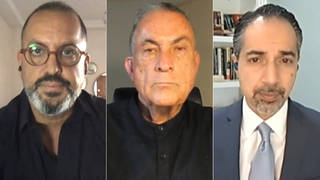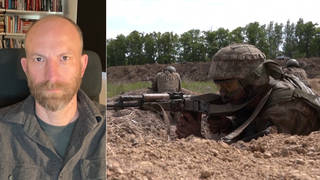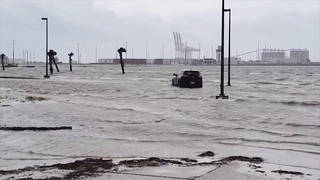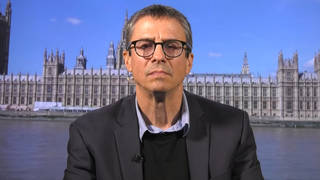
Related
Topics
The New Orleans Times-Picayune wrote three years ago, “It’s only a matter of time before south Louisiana takes a direct hit from a major hurricane. Billions have been spent to protect us, but we grow more vulnerable every day.” We look at the lack of infrastructure preparedness in the Big Easy. [includes rush transcript]
The death toll from Hurricane Katrina continues to climb dramatically with the mayor of New Orleans estimating that the number of dead in the devastated city could well be in the thousands. Conditions continue to deteriorate after two levees broke, sending water coursing through the streets. An estimated 80 percent of the city–which lies below sea level–is under water, up to 20 feet deep in places with miles and miles of homes swamped. Food and water supplies are dwindling and bodies float in the floodwaters. As the evacuation of the Superdome begins, officials said there was no choice but to abandon the city, perhaps for months.
As the devastation continues to unfold, many people around the country are wondering how a catastrophe of this magnitude could have occurred. Well, some have been warning of such an impending disaster for years. Three years ago, the New Orleans Times-Picayune won journalism awards for an exhaustive five-part series called “Washing Away” which began with the words: “It’s only a matter of time before south Louisiana takes a direct hit from a major hurricane. Billions have been spent to protect us, but we grow more vulnerable every day.” The newspaper seems to be living its own prophecy. As the hurricane passed but the water continued to rise, the staff of the Times-Picayune was forced to evacuate its downtown headquarters.
- Mark Fischetti, contributing editor of Scientific American. In 2001 he wrote an article titled “The Drowning of New Orleans” that warned only massive reengineering of southeastern Louisiana could save New Orleans from a catastrophic flood.
- John McQuaid, reporter for the Washington bureau of the New Orleans Times-Picayune. He co-authored Washing Away, a major investigative series in 2002 examining the implications of a hurricane like Katrina hitting New Orleans.
Transcript
AMY GOODMAN: We’re joined right now by John McQuaid, he works in the Washington Bureau of the Times-Picayune, he is one of the co-authors of that 2002 series called Washing Away. We’re also joined in Massachusetts by journalist, Mark Fischetti, he is a contributing editor of Scientific American. In 2001, a year before Washing Away, he wrote the article entitled, The Drowning of New Orleans that warned only massive reengineering of Southeastern Louisiana could save New Orleans from a catastrophic flood. We welcome you both to Democracy Now!, And we begin with John McQuaid in Washington, D.C.— the Washington reporter for the Times-Picayune. First of all, our condolences on all that is happening in your state and with your colleagues. Can you talk about your knowledge of the latest, but, what you understood for years, what you have written about?
JOHN MCQUAID: The corps of engineers announced yesterday that the water coming into the city had stopped. Basically the water inside the city kept rising, and the level of Lake Pontchartrain, which was the source of the water, was gradually falling after the storm and was equalized sometime yesterday morning. So that gave them a little bit of relief in at least the situation was not worsening. They then were dropping giant sandbags, 15,000 pound sandbags into the largest breach in the levee where the water had been coming in. And then they were going to embark on several projects to cut open levees at other places to allow water to flow out. And to fix pumps, that can pump water out. There have been different estimates as to how long it will take to pump all of the water out. They were saying 30 days. I guess the Los Angeles Times is quoting someone saying it could take much longer than that. So, that’s sort of the flood situation.
JUAN GONZALEZ: And in terms of your series, could you for those of our listeners and viewers around the country who are not familiar with it, talk about some of the main findings that your series of articles uncovered?
JOHN MCQUAID: Sure. There are two main problems. One is that the coastline, the entire region of New Orleans and its surrounding areas are built on is sinking and eroding due to a number of different factors. It’s been doing that essentially since the people started living there. Over the years, it’s gotten lower. They have built levees and other structures to prevent floodwaters from hurricanes and heavy rains and other things from staying in this area. Get them out and keep them from penetrating into it. But the problem continues to get worse. So, the government is constantly playing catch-up to construct levees, to build up existing structures, to build new structures, and essentially they never caught up.
AMY GOODMAN: We’re also joined by Mark Fischetti, contributing editor of Scientific American. You wrote the piece, The Drowning of New Orleans, warning that massive re-engineering of Southeastern Louisiana could save New Orleans from a catastrophic flood. Talk more about this. Talk about what you are seeing today and what you were warning, not one, not two, was it more than three years ago in 2001?
MARK FISCHETTI: Yeah. Right. It was 2001, and a lot of what that was predicated on was actually a plan that was put together in 1998 by a number of local scientists, engineers, and the governor’s office of Louisiana, which basically showed with computer models what would happen if a hurricane came in this direction and hit New Orleans directly. The models pretty much predicted exactly what’s happened, so this whole group of experts down there came up with a pretty consolidated plan of four or five major steps that should be taken to protect the city and the delta as much as possible. The plan came out and really didn’t get a whole lot of response on a national level. It was an expensive program, as you might have imagined, and it sort of was just left there.
JUAN GONZALEZ: And John McQuaid, your articles were amazingly describing the scenarios of the experts that you talked to about the potential catastrophe in New Orleans from a direct hit from a hurricane. It’s amazing how precisely those predictions have turned out to be as a result of this hurricane. Could you talk about what you warned then of the potential — how the disaster would play out?
JOHN MCQUAID: Yes. All the experts looked at the basic topography and they saw that New Orleans was on average five feet below sea level. The lake is one-and-a-half feet above sea level, and so — all that’s between them is the levee system, so if the levee system is over topped by a large storm surge from a hurricane or if it is breached, as happened in this case, then you get a flood the bowl situation where water just flows into the city from the lake, basically until it’s at the same level in both, and that means essentially the entire city of New Orleans under w ater. There’s no easy way to get rid of that water. In most flood situations, in natural disasters, floods like the tsunami or river floods, the water will rise very quickly and then it will disappear relatively quickly. In this situation, it’s just stuck there, and there’s no way to get it out. Electricity that powers the pumps is down. The pumps are inundated. They don’t work. So, you have a situation of standing water, and as was mentioned at the top of the program, you have all of the waste, garbage, dead bodies, some of it quite toxic, is just floating around in that. So, and it gets worse the longer it goes on. So, the corps of engineers is desperately trying to get that water out of there, but again, it’s the type of thing where you have to cut holes in the levee and pump the water out, and that just takes a very long time. So, it’s a very unique and horrible situation.
JUAN GONZALEZ: Well, as we reported yesterday in several other media have over the past few days, the Federal government began a project in 1995 to shore up the levees and improve New Orleans’ ability to withstand this type of flooding, but your newspaper has written many articles over the last few years talking about the problems with that program, and the cutbacks that occurred in the funding for it. Could you talk about that as well?
JOHN MCQUAID: There are basically two big programs underway. One has to do with flooding within the city and surrounding areas. The other has to do with hurricane protection and levee protection. The first is the one that had its funding cut. Some of that funding was also going to hurricane protection, and in the past few years, it’s been very difficult for local officials and members of Congress from Louisiana to get money consistently to fund those things. The Bush administration has obviously had its attention focused in terms of the budget on Iraq, on domestic terrorism needs, and it’s been looking to cut back in the corps of engineers. The corps of engineers has a — history of — some say, of wasting money on large projects, however, in this case, these projects are absolutely vital to protecting the city. So, every year there’s been a big scramble to get more money. They have had some of it restored, but when you are sort of constantly fighting budget cuts coming from the administration, it’s just been very difficult and local people and members of Congress have been complaining about this for a long time.
AMY GOODMAN: President Bush proposing significantly reducing the amount of Federal money, proposing spending $10 million. Local officials saying six times as much money was needed.












Media Options